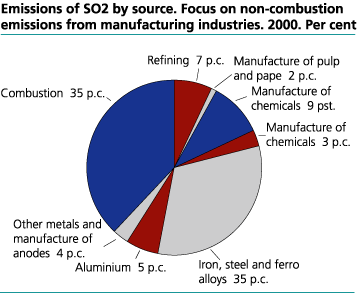Content
Published:
This is an archived release.
Sulphur emissions halved since 1990
The Norwegian emissions of sulphur dioxide are more than halved since 1990. In 2001, the emissions were reduced by 3 per cent from the preceding year, partly because of less activity in the process industries.
In 1999, Norway signed the Gothenburg Protocol on limitations of long-range pollution in Europe. This Protocol commits Norway to reduce the SO2 emissions to 22 000 tonnes within 2010. This equals a reduction of approximately 58 per cent from the 1990 level. Provisional calculations from Statistics Norway and the Norwegian Pollution Control Authority estimate the Norwegian SO2 emissions in 2001 at approximately 25 400 tonnes, which is 800 tonnes less than the preceding year. Further reductions in the SO2 emissions are thus required to meet the obligations in the Gothenburg Protocol.
Lower emissions from the manufacturing industries
While combustion emissions from the manufacturing industries increase because of more use of oil products as fuel, emissions from industrial processes have been reduced by 2 500 tonnes. Most of last year's decrease is due to trade fluctuations and not to environmental measures; accordingly, emissions may again increase in the future. Some industries are having a difficult period, which results in lower production of some goods that contribute much to SO2 emissions. The decrease in production of ferro alloys was particularly sharp in 2001, resulting in a reduction in SO2 emissions of 1 400 tonnes from the preceding year.
...but manufacturing industries still have the highest emissions
In 2000, manufacturing industries were responsible for almost 80 per cent of the SO2 emissions. Only one sixth of this was due to combustion; the remainder came from different industrial processes. Among the process emissions, metal production was most important, causing 44 per cent of the total SO2 emissions in Norway. 9 per cent came from carbide production.
Emissions from processes and combustion in the manufacturing industries constituted 78 per cent of Norwegian SO2 emissions in 2000. Respectively 11 and 3 per cent came from domestic sea transport and road traffic. Residential heating was responsible for 2 per cent of the emissions, while the remaining 6 per cent came from other sources.
More than halved from 1990
The SO2 emissions have thus been more than halved in the period 1990-2001. The strong reduction is due to increased cleansing of emissions from manufacturing industries, changeover from use of fossil fuels to electricity, use of lighter petroleum products and less sulphur in oil products and reducing agents. The tax on auto diesel with high sulphur content (more than 0.005 per cent) has proved to be efficient, as the oil companies quickly reduced the sulphur content in auto diesel after the introduction of the tax by January 1 2000.
International sea transport not included in the figures
Emissions from international air and sea transport are not included in the Gothenburg Protocol. International air traffic causes only minor SO2 emissions. Bunkers for international sea transport, however, contributed to emissions of 13 000 tonnes SO2 in 2001, which corresponds to half of the national emissions. Parts of these emissions do, however, take place outside Norwegian waters.
Emissions of SO2 differ from, e.g., CO2 emissions in the possibility of reductions through technical means. In comparison, there is today no commercial available technique for removing CO2; these emissions are thus more closely connected to use of fuels and industrial production.
Tables ( Norwegian text )
Figure ( Norwegian text )
Other articles concerning emissions to air
The statistics is published with Emissions to air.
Contact
-
Statistics Norway's Information Centre
E-mail: informasjon@ssb.no
tel.: (+47) 21 09 46 42


